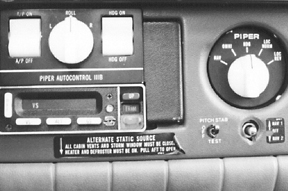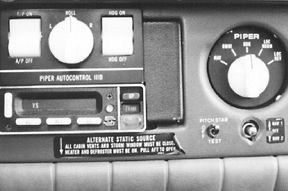
In many airplanes, if a rerouting means you need to focus for a few moments on a chart, you push a button. Feel spatial disorientation coming on? Throw a switch. Find yourself weaving across the localizer and theres electronic assistance waiting there, too.
All of these scenarios rely on the autopilot, arguably the most frequently used piece of untested equipment on an airplane.
One of the many problems that come up with respect to autopilots is that a lot of pilots dont know how they work or even why they work. George is frequently left off the preflight checklist. The supplements required to be added to the POH in aftermarket installations are frequently missing.
Whats worse, even some pilots who routinely let the computer fly the airplane down to minimums on an approach cant explain what would happen if one of the components were to fail. Some are ignorant as to how that particular autopilot is tied into the aircrafts systems or how a failure of one component affects the others.
Operating autopilots, like many advanced avionics, can fall outside of the aircraft checkout renters go through before they can use the airplanes at an FBO. One Aviation Safety editor found that, in a string of 21 aircraft checkouts, the instructor covered autopilot operations only once – and even that was limited to operation, not failure modes or quick disconnection.
The same problem exists for owners. When you buy an airplane, the insurance-required checkout typically involves stalls, steep turns and a handful of touch and goes. Few instructors delve more deeply into aircraft systems unless you take recurrent training at a company such as FlightSafety or SimCom.
Yet the autopilot can be a complex piece of equipment, depending on the installation. It can combine components from different manufacturers, with different interfaces and different failure modes.
It also involves complex interactions among the airplanes systems to keep it flying smoothly.
Failure of one of the autopilot components, including the electric trim in altitude-hold models, can lead to abrupt deviations in flight path – even to the point of inducing structural failure or loss of aircraft control. Yet Part 91 operators, free from regulations dictating how the autopilots should be operated, continue to launch without checking out the system to verify its bug-free.
But even a successful preflight check is no guarantee that the autopilot will work as advertised. The autopilots system of servos and controllers depends on the airplanes instrumentation to pick the right course and altitude and stick with it.
How They Work
There are two primary kinds of autopilots in light airplanes, position (or horizon) based and rate based. In either case they are stabilized by a gyro.
The position-based autopilot interprets the movement of the gyro and generates a command that leads the airplane to right itself from whatever pitch or roll deviation it sensed. The gyro of choice in many systems is the attitude indicator.
In this configuration, the autopilot is very responsive – so much so that leaving a position-based autopilot engaged in turbulence can lead to overstressing the airplane. But dependent as it is on the attitude indicator, if that gyro loses speed from a loss of vacuum, tumbles due to extreme pitch changes or fails internally, the autopilot becomes unreliable and disengages.
Before disengaging, however, the autopilot may roll the airplane inverted or dive it toward the ground at speeds exceeding Vne. Thats why its important that pilots operating the autopilot continuously monitor the operation of the unit as well as continue a standard instrument scan – including the vacuum gauge if the autopilot operates from a vacuum-powered instrument.
Rate-based autopilots typically work off the turn coordinator, which tends to be more reliable than the vacuum-driven gyros typically installed as primary flight instruments. The rate-based system detects a roll as little as 1/16,000th of a degree per second. The computer then calculates the airplanes attitude and instructs the servos to take appropriate action.
The rate-based system also uses an accelerometer that measures whether the rate of change is increasing or decreasing, which then allows it to follow the proper trends to keep the airplane on the intended track.
Rate-based systems wont tumble and they dont rely on the airplanes vacuum system or attitude indicator. But because theyre electric, an alternator or buss failure can put the pilot into trouble similar to a vacuum failure. One key difference is that an alternator failure still leaves the pilot with battery power during which he can attempt to get to VFR conditions.
Regardless of the system, autopilots that are more than simple wing levelers can then detect whether the airplane is on the correct heading or tracking the navigational signal correctly, if thats what its supposed to do.
Autopilots that incorporate altitude hold work off of the airplanes electric trim. While this adds capability, it also adds another layer of risk.
If, for example, the airplane is trying to turn or climb and the pilot overpowers the autopilot manually, the airplane will continue to try to correct the pilots inputs, forcing the pilot to push harder. If the autopilot is then disengaged, the airplane can be upset easily.
Some airplanes cruise faster than Va. In those airplanes, an autopilot excursion can result in overstressing the airplane when the autopilot is finally disengaged.
Why They Work
Most autopilots are coupled to the attitude indicator and the directional gyro, although some use the turn coordinator instead. The gyro instruments are plumbed so that the autopilot can pick off information from it.
An electronic pickoff consists of three small coils attached to the instrument case and a metal vane attached to the gyro gimbal. The autopilot induces a magnetic field in one coil, which is conducted by the metal vane to the other two coils.
If the voltages in the two outer coils is the same, the autopilot concludes the metal vane is centered. If they are not the same, the autopilot calculates the difference and determines the position of the gyro, then compares its current position with its concept of what the airplane should be doing at that point.
The attitude indicator has two sets of coils. One set senses the bank angle, the other the pitch angle. Another one in the DG or HSI drives the autopilots ability to capture and track the heading bug.
This reliance on the gyros means the autopilot will try to follow the gyro as it spins down and becomes inaccurate. The autopilot usually cant detect the failure, so it remains engaged until the aircraft assumes such an extreme attitude that the autopilot cant correct anymore and disconnects itself. Some autopilots and gyros incorporate vacuum or electric failure flags, but many do not.
If the failure goes undetected long enough, the airplane may be on the verge of structural failure when the pilot does try to recover. The recovery can induce failure, or it may be too late to avoid an inflight breakup or collision with the ground.
How They Fail
Any discussion of the failure modes of the autopilot has to begin with the obvious. At the first sign the autopilot is acting up, shut it down immediately. (This includes electric trim, too.) Make sure you know how to disengage the autopilot at every source, including the circuit breaker, control head and yoke switch, without subjecting the airplane to dangerous control excursions.
Because the autopilot is intended to reduce workload, its tempting to discount the work the unit can generate. However, failure can come from a number of sources.
Most obvious are failures in the instruments that provide feedback to the autopilot, such as the attitude indicator, directional gyro and turn coordinator. Vacuum failures and electrical failures also affect different autopilots in different ways. Before you engage an autopilot in flight, know what instruments it relies on, how those instruments are powered, and what the autopilot will do if power or control information is lost. Dont assume the autopilot will simply disconnect itself; thats often not the case.
Sometimes an apparent failure is operator error rather than autopilot error – a stark reminder of how little some pilots know about operating the box. For example, if youre flying a King KFC-150 autopilot and make a tight turn onto the localizer yet under the glideslope, the unit can get confused to the point that it will not capture the approach properly. If youre PIC, you need to know what the symptoms of that failure are and what to do about it. Hint: Youre not likely to find the answer in the POH supplement.
Other times, presumed failures are associated with flight instruments, such as the HSI. There are several internal faults within the HSI that can lead to incorrect displays even though the autopilot is working properly.
Some airplanes with advanced autopilots have experienced pitch oscillations due to failure of the altitude encoder. Depending on how the encoder fails the airplane may pitch wildly trying to capture the proper vertical speed.
There are other failure modes that can lead to attitude excursions as well. Loose bridle cables on the servos can put the autopilot behind the airplane. The servo has to take up slack before the control surfaces move but, while thats happening, the airplane is flying through the reference the autopilot is trying to maintain.
The servos themselves need periodic maintenance, which is often ignored by owners. An autopilot that rocks back and forth simply trying to achieve wings-level may need its servos cleaned. However, that can also be a symptom of poor aircraft rigging. When the autopilot thinks the control surfaces are neutral, they are in fact deflected somewhat, leaving the computer to play a never-ending game of catch-up.
Flying on Auto
One of the problems with autopilot operations is that the airplanes in which theyre installed frequently dont include the proper POH supplements, particularly if theyre rentals. In addition, even pilots who do have access to the required paperwork often dont take the time to review emergency procedures.
Autopilot failures, like any other emergency, should be practiced periodically to the extent possible in good weather at altitude. Perhaps no other system on board relies so heavily on everything else working. The autopilot operation, then, is a high-trust but high-risk operation. Make sure your faith is not misplaced.
Autopilots are nice for long flights, where they help alleviate fatigue, or during periods of high workload, when they take over simple flight so you can concentrate momentarily on something else. They often fly the airplane nicely, which both pilots and passengers enjoy.
But in exchange for those attributes, the pilot needs to be intimately familiar with the autopilot operation and failure, especially how to cope with one failure without creating another.
Also With This Article
Click here to view “Common Autopilot Failure Modes.”
Click here to view “Tricks and Traps.”




